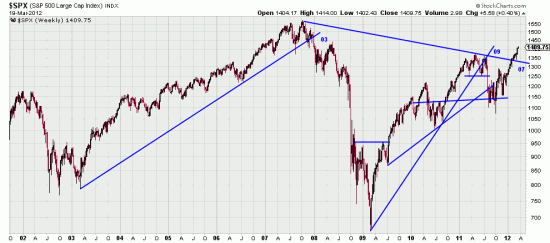
http://stockcharts.com/h-sc/ui?s=$SPX&p=W&yr=10&mn=6&dy=0&id=p80479235585&a=239474174
Not a single analyst, pundit, tea leaf reader, investment scam letter — literally no one has remarked, or noticed perhaps the most important technical fact about the present market. You have to look at a five year chart to see it. The trendline is drawn from the top in October 07, crosses the top of the head-and-shoulders pattern in May 11 and has been broken by the current upwave. If you should have any residual doubts about the power of broken trend lines look at the broken trend lines from 03 and 09. The longer the line the larger the implications. This present line is 53 (m/l — more or less) months long! We have often noted the phenomenon of prices accelerating as they approach important trendlines (though calling the last 50 days of action acceleration might call into question the definition of acceleration).
Now in the SPX prices are (m/l) 10% away from the Oct 07 high of 1546.72. The breaking of this high will set the stage for a major bull market. Please note that your correspondents have not been kidnapped by aliens and injected with joy juice on the mother ship. As our readers know forecasting is our least favorite thing to do. On the other hand we owe readers our unvarnished (but hopefully sanded) analysis of the state of the markets.
While there is every likelihood of a sharp correction sometime in the near future, there is every sign that over the next two years we will see large market gains.
Two of these signs we have mentioned above. Others we have been discussing for several weeks, and we will summarize them below. Engrained in the science (science? Art? Craft? (Art and Craft?) discipline? Hobby?) of technical analysis is the concept of proportionality — that one thing leads to the other — or what Wyckoff called Cause and Effect. Edwards and Magee acknowledge the phenomenon — measuring the potential move of prices from a head-and-shoulders or rectangle formation by analyzing the depth of the formation.
Wyckoff (and practitioners of point and figure charting) has attempted to scientize this process with the PnF chart. The procedure is a little different for Wyckoff and current practitioners. We have explained it at a previous letter: http://www.edwards-magee.com/?p=3282
Wild targets fell out of that analysis — 1460 from the conventional and 1860 for the Wyckoff procedure. Then Barron’s published a front page prediction of Dow 15000 — and perhaps 17000 — using a cyclical method. This they thought possible in two years.
 This updated PnF looks for a target of 1820. As wild as that seems it is confirmed by that other old technique from the technician’s toolchest the rule of seven. Here is a link to that letter: http://www.edwards-magee.com/?p=3296
This updated PnF looks for a target of 1820. As wild as that seems it is confirmed by that other old technique from the technician’s toolchest the rule of seven. Here is a link to that letter: http://www.edwards-magee.com/?p=3296
Readers should note from the dates of these letters that we have been on the leading edge of this wave — many of these letters were written in January.
Now here’s what we are going to do with these crystal ball predictions — wad them up and throw them in the wastebasket. We will do one thing though — in our trading now we will always have a long position on, rather than wave surfing. While it is totally possible that adroit stock selection could outperform the major indices we prefer (and are satisfied by) the majors. Stock picking is too much like horse handicapping for us.

